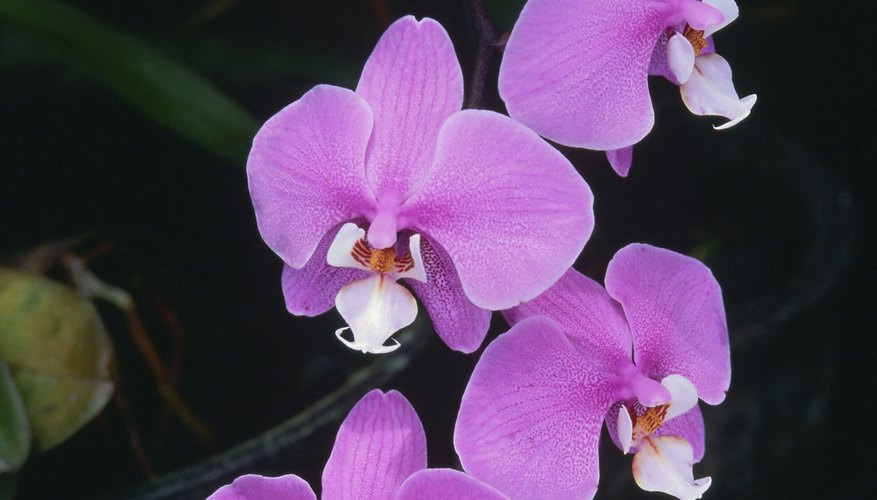Orchids represent the largest family of plants in the world, with a wide variety of features that help them to survive in a range of habitats around the world. Orchids have existed for around 100 million years, according to the Marie Selby Botanical Gardens, and have developed adaptations in that time to allow them to thrive anywhere from the side of a rock to the high branches of a tall tree.
Roots
Orchid roots are highly adapted and are essential to the plant’s survival. Varieties that grow in the ground often feature tubers which store water and help the orchid to survive at times when water is scarce. Orchids that grow in habitats away from the ground, such as around the branch of a tree rely on their roots in many ways. The roots of these orchids have a thick absorbent coating called a velamen which stores water and may also allow the plant to absorb moisture from the air around it. Some epiphytic orchid varieties, which do not grow in the ground, have root cells that are capable of photosynthesis, giving the plant energy from the sunlight that its roots receive.
- Orchid roots are highly adapted and are essential to the plant’s survival.
- Varieties that grow in the ground often feature tubers which store water and help the orchid to survive at times when water is scarce.
Leaves
Leaves vary greatly between orchid varieties as they have adapted to help plants survive in varying conditions. In some cases, the leaves are able to store water for the plant as well as allowing it to photosynthesise. Orchids that grow high up in the rainforest have some of the thickest leaves, with a waxy surface that helps to prevent the plant from losing moisture. Varieties that grow on the forest floor only require very thin leaves as there is less risk of losing water through strong, direct sunlight and the atmosphere tends to be moist at the bottom of a rainforest. However, the varieties that grow in the canopy have developed adaptations such as thin, curling leaves that mean little of their surface area is exposed to the drying effects of the strong sunlight.
- Leaves vary greatly between orchid varieties as they have adapted to help plants survive in varying conditions.
- Orchids that grow high up in the rainforest have some of the thickest leaves, with a waxy surface that helps to prevent the plant from losing moisture.
Stem
Many orchids have stems that feature pseudobulbs, where portions of the stem can swell up to facilitate the storage of water. In some cases, pseudobulbs can also store carbohydrates. This adaptation means that orchids can survive for long periods of time without absorbing new water and helps them to live in habitats that receive no rain for months at a time.
Reproduction
Orchids have a number of adaptations that aid reproduction. The wide variety of colours, scents and shapes of orchid petals have often been adapted to attract the bird of insect that pollinates it. One of an orchid’s petals tends to be coloured in a way that attracts a pollinator and positioned so that it is easy to land on and guides the pollinator directly to the reproductive organ. However, some orchids have a structure that allows them to pollinate themselves, with a flexible male reproductive part that can curl around to pollinate the female part that it also located within the flower.
- Orchids have a number of adaptations that aid reproduction.
- One of an orchid’s petals tends to be coloured in a way that attracts a pollinator and positioned so that it is easy to land on and guides the pollinator directly to the reproductive organ.
